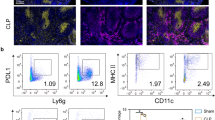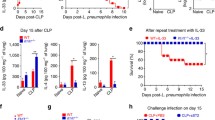Abstract
Sepsis still emerges as a major cause of patient death in intensive care units. Therefore, new therapeutic approaches are mandatory. Because during sepsis progression cytotoxic T lymphocytes (CTLs) can be activated in an autoimmune fashion contributing to multiorgan damage, it remains unclear whether CTLs are activated toward alloantigenic cells. This is important for patients receiving an immunosuppressive therapy to permit organ transplantation and, thus, known to be at high risk for developing sepsis. Therefore, we analyzed whether sepsis activates CTL toward alloantigenic target cells and whether this can be inhibited by PPARγ activation, known to block T helper cell responses. To mimic septic conditions, CTLs were isolated from cecal ligation and puncture-operated mice. CTL cytotoxicity was analyzed following a direct alloantigenic activation regime or following classical ex vivo splenocyte-driven activation in a cytotoxicity assay. With this readout, we found that CTL derived from septic mice enhanced cytotoxicity toward alloantigenic target cells, which was lowered by in vivo and ex vivo PPARγ activation. With CTL derived from T cell-specific PPARγ knockout mice, PPARγ activation was ineffective, pointing to a PPARγ-dependent mechanism. In vivo and ex vivo PPARγ activation reduced Fas and granzyme B expression in activated CTL.
Key message
-
In the sepsis CLP mouse model, CTLs are activated toward alloantigenic target cells.
-
Sepsis-mediated alloantigenic CTL activation is blocked in vivo by PPARγ activation.
-
PPARγ deletion or antagonization restored rosiglitazone-dependent inhibition of CTL cytotoxicity.
-
PPARγ inhibits the expression of Fas and granzyme B in CTLs.








Similar content being viewed by others
References
Angus DC, van der Poll T (2013) Severe sepsis and septic shock. N Engl J Med 369(9):840–851
Kumar A, Zarychanski R, Light B, Parrillo J, Maki D, Simon D, Laporta D, Lapinsky S, Ellis P, Mirzanejad Y et al (2010) Early combination antibiotic therapy yields improved survival compared with monotherapy in septic shock: a propensity-matched analysis. Crit Care Med 38:1773–1785
Donnelly JP, Blijlevens NM, van der Velden WJ (2014) Host impairments in patients with neoplastic diseases. Cancer Treat Res 161:1–41
Howell J, Sawhney R, Testro A, Skinner N, Gow P, Angus P, Ratnam D, Visvanathan K (2013) Cyclosporine and tacrolimus have inhibitory effects on toll-like receptor signaling after liver transplantation. Liver Transpl 19:1099–1107
Getts DR, Shankar S, Chastain EM, Martin A, Getts MT, Wood K, Miller SD (2011) Current landscape for T-cell targeting in autoimmunity and transplantation. Immunotherapy 3(7):853–870
Womer KL, Kaplan B (2009) Recent developments in kidney transplantation—a critical assessment. Am J Transplant 9:1265–1271
Harrison JJ, Schiff JR, Coursol CJ, Daley CJ, Dipchand AI, Heywood NM, Keough-Ryan TM, Keown PA, Levy GA et al (2012) Generic immunosuppression in solid organ transplantation: a Canadian perspective. Transplantation 93:657–665
Golshayan D, Pascual M (2008) Tolerance-inducing immunosuppressive strategies in clinical transplantation: an overview. Drugs 68:2113–2130
Fishman JA (2007) Infection in solid-organ transplant recipients. N Engl J Med 357:2601–2614
Thayer C, Bartlett ST, Ward RE (1990) Increased septic complications with three-drug sequential immunosuppression for cadaver renal transplants. Am J Surg 160:614–617
Huang SS, Septimus E, Kleinman K, Moody J, Hickok J, Avery TR, Lankiewicz J, Gombosev A, Terpstra L, Hartford F et al (2013) Targeted versus universal decolonization to prevent ICU infection. N Engl J Med 368:2255–2265
Wesche-Soldato DE, Chung CS, Gregory SH, Salazar-Mather TP, Ayala CA, Ayala A (2007) CD8+ T cells promote inflammation and apoptosis in the liver after sepsis: role of Fas-FasL. Am J Pathol 171:87–96
Hotchkiss RS, Monneret G, Payen D (2013) Sepsis-induced immunosuppression: from cellular dysfunctions to immunotherapy. Nat Rev Immunol 12:862–874
Hotchkiss RS, Coopersmith CM, McDunn JE, Ferguson TA (2009) The sepsis seesaw: tilting toward immunosuppression. Nat Med 15:496–497
Oberholzer C, Oberholzer A, Clare-Salzler M, Moldawer LL (2001) Apoptosis in sepsis: a new target for therapeutic exploration. FASEB J 15:879–892
Boomer JS, To K, Chang KC, Takasu O, Osborne DF, Walton AH, Bricker TL, Jarman SD 2nd, Kreisel D, Krupnick AS et al (2011) Immunosuppression in patients who die of sepsis and multiple organ failure. JAMA 306:2594–2605
Schmidt MV, Paulus P, Kuhn AM, Weigert A, Morbitzer V, Zacharowski K, Kempf VA, Brune B, von Knethen A (2011) Peroxisome proliferator-activated receptor gamma-induced T cell apoptosis reduces survival during polymicrobial sepsis. Am J Respir Crit Care Med 184:64–74
Kidani Y, Bensinger SJ (2012) Liver X receptor and peroxisome proliferator-activated receptor as integrators of lipid homeostasis and immunity. Immunol Rev 249(1):72–83
Kiss M, Czimmerer Z, Nagy L (2013) The role of lipid-activated nuclear receptors in shaping macrophage and dendritic cell function: from physiology to pathology. J Allergy Clin Immunol 132:264–286
Ahmadian M, Suh JM, Hah N, Liddle C, Atkins AR, Downes M, Evans RM (2013) PPARgamma signaling and metabolism: the good, the bad and the future. Nat Med 19:557–566
Glass CK, Saijo K (2010) Nuclear receptor transrepression pathways that regulate inflammation in macrophages and T cells. Nat Rev Immunol 10:365–376
Tautenhahn A, Brune B, von Knethen A (2003) Activation-induced PPARgamma expression sensitizes primary human T cells toward apoptosis. J Leukoc Biol 73:665–672
Wang YL, Frauwirth KA, Rangwala SM, Lazar MA, Thompson CB (2002) Thiazolidinedione activation of peroxisome proliferator-activated receptor gamma can enhance mitochondrial potential and promote cell survival. J Biol Chem 277:31781–31788
Clark RB, Bishop-Bailey D, Estrada-Hernandez T, Hla T, Puddington L, Padula SJ (2000) The nuclear receptor PPAR gamma and immunoregulation: PPAR gamma mediates inhibition of helper T cell responses. J Immunol 164:1364–1371
Yang XY, Wang LH, Chen T, Hodge DR, Resau JH, DaSilva L, Farrar WL (2000) Activation of human T lymphocytes is inhibited by peroxisome proliferator-activated receptor gamma (PPARgamma) agonists. PPARgamma co-association with transcription factor NFAT. J Biol Chem 275:4541–4544
Akiyama TE, Sakai S, Lambert G, Nicol CJ, Matsusue K, Pimprale S, Lee YH, Ricote M, Glass CK, Brewer HB Jr et al (2002) Conditional disruption of the peroxisome proliferator-activated receptor gamma gene in mice results in lowered expression of ABCA1, ABCG1, and apoE in macrophages and reduced cholesterol efflux. Mol Cell Biol 22:2607–2619
Cui Y, Miyoshi K, Claudio E, Siebenlist UK, Gonzalez FJ, Flaws J, Wagner KU, Hennighausen L (2002) Loss of the peroxisome proliferation-activated receptor gamma (PPARgamma) does not affect mammary development and propensity for tumor formation but leads to reduced fertility. J Biol Chem 277:17830–17835
Hennet T, Hagen FK, Tabak LA, Marth JD (1995) T-cell-specific deletion of a polypeptide N-acetylgalactosaminyl-transferase gene by site-directed recombination. Proc Natl Acad Sci U S A 92:12070–12074
Rittirsch D, Huber-Lang MS, Flierl MA, Ward PA (2009) Immunodesign of experimental sepsis by cecal ligation and puncture. Nat Protoc 4:31–36
Gajewski TF, Markiewicz MA, Uyttenhove C (2001) The p815 mastocytoma tumor model. Curr Protoc Immunol 20:20–24
Zhai Y, Meng L, Busuttil RW, Sayegh MH, Kupiec-Weglinski JW (2003) Activation of alloreactive CD8+ T cells operates via CD4-dependent and CD4-independent mechanisms and is CD154 blockade sensitive. J Immunol 170:3024–3028
van den Berg JW, van der Zee M, de Bruin RW, van Holten-Neelen C, Bastiaans J, Nagtzaam NM, IJzermans JN, Benner R, Dik WA (2011) Mild versus strong anti-inflammatory therapy during early sepsis in mice: a matter of life and death. Crit Care Med 39:1275–1281
Inoue S, Suzuki-Utsunomiya K, Okada Y, Taira T, Iida Y, Miura N, Tsuji T, Yamagiwa T, Morita S, Chiba T et al (2013) Reduction of immunocompetent T cells followed by prolonged lymphopenia in severe sepsis in the elderly. Crit Care Med 41:810–819
Soller M, Tautenhahn A, Brune B, Zacharowski K, John S, Link H, von Knethen A (2006) Peroxisome proliferator-activated receptor gamma contributes to T lymphocyte apoptosis during sepsis. J Leukoc Biol 79:235–243
Ferreira AE, Sisti F, Sonego F, Wang SJ, Filgueiras LR, Brandt S, Serezani APM, Du H, Cunha FQ, Alves JC et al (2014) PPAR-gamma/IL-10 axis inhibits MyD88 expression and ameliorates murine polymicrobial sepsis. J Immunol 192:2357–2365
Kaplan JM, Hake PW, Denenberg A, Nowell M, Piraino G, Zingarelli B (2010) Phosphorylation of extracellular signal-regulated kinase (ERK)-1/2 is associated with the downregulation of peroxisome proliferator-activated receptor (PPAR)-gamma during polymicrobial sepsis. Mol Med 16:491–497
Zingarelli B, Hake P, Fan H, Denenberg A, Mangeshkar P, Piraino G, Cook JA (2007) Macrophage deficiency of peroxisome proliferator activated receptor gamma (PPAR gamma) exacerbates neutrophil infiltration in the gut in sepsis. Shock 27:16–16
Zingarelli B, Sheehan M, Denenberg A, Wong HR, Cook JA (2001) Therapeutic effects of 15-deoxy-delta 12,14-prostaglandin J(2) (15d-PGJ(2)), a peroxisome proliferator-activated receptor-gamma (PPAR gamma) ligand, in experimental sepsis. Crit Care Med 29:A86–A86
Kosuge H, Haraguchi G, Koga N, Maejima Y, Suzuki J, Isobe M (2006) Pioglitazone prevents acute and chronic cardiac allograft rejection. Circulation 113:2613–2622
Yan Z, Yi H, Jing H, Changyi L, Wang D, Xuemei R, Daoxing W (2013) Rosiglitazone, a peroxisome proliferator-activated receptor-gamma agonist, attenuates airway inflammation by inhibiting the proliferation of effector T cells in a murine model of neutrophilic asthma. Immunol Lett 157:9–15
Lasham A, Lindridge E, Rudert F, Onrust R, Watson J (2000) Regulation of the human Fas promoter by YB-1, Puralpha and AP-1 transcription factors. Gene 252:1–13
Babichuk CK, Duggan BL, Bleackley RC (1996) In vivo regulation of murine granzyme B gene transcription in activated primary T cells. J Biol Chem 271:16485–16493
Rengarajan J, Mittelstadt PR, Mages HW, Gerth AJ, Kroczek RA, Ashwell JD, Glimcher LH (2000) Sequential involvement of NFAT and Egr transcription factors in FasL regulation. Immunity 12:293–300
Daynes RA, Jones DC (2002) Emerging roles of PPARs in inflammation and immunity. Nat Rev Immunol 2:748–759
Wargnier A, Lafaurie C, Legros-Maida S, Bourge JF, Sigaux F, Sasportes M, Paul P (1998) Down-regulation of human granzyme B expression by glucocorticoids. Dexamethasone inhibits binding to the Ikaros and AP-1 regulatory elements of the granzyme B promoter. J Biol Chem 273:35326–35331
Nissen SE, Wolski K (2007) Effect of rosiglitazone on the risk of myocardial infarction and death from cardiovascular causes. N Engl J Med 356:2457–2471
Tan Y, Muise ES, Dai H, Raubertas R, Wong KK, Thompson GM, Wood HB, Meinke PT, Lum PY, Thompson JR et al (2012) Novel transcriptome profiling analyses demonstrate that selective peroxisome proliferator-activated receptor gamma (PPARgamma) modulators display attenuated and selective gene regulatory activity in comparison with PPARgamma full agonists. Mol Pharmacol 82:68–79
Acknowledgments
This research was supported by a grant from the Deutsche Forschungsgemeinschaft (KN493/11-1 and SFB 815 TP3). The work has been supported by the Else Kröner-Fresenius Foundation (EKFS), Research Training Group Translational Research Innovation—Pharma (TRIP), and the Landesoffensive zur Entwicklung wissenschaftlich-ökonomischer Exzellenz (LOEWE), Schwerpunkt: Anwendungsorientierte Arzneimittelforschung. We thank Nadja Wallner for the excellent technical assistance.
Conflict of interest
The authors declare no conflict of interest related to this study.
Author information
Authors and Affiliations
Corresponding author
Electronic supplementary material
Below is the link to the electronic supplementary material.
ESM 1
(PDF 559 kb)
Rights and permissions
About this article
Cite this article
von Knethen, A., Sha, L.K., Knape, T. et al. Activation of the peroxisome proliferator-activated receptor γ counteracts sepsis-induced T cell cytotoxicity toward alloantigenic target cells. J Mol Med 93, 633–644 (2015). https://doi.org/10.1007/s00109-014-1249-8
Received:
Revised:
Accepted:
Published:
Issue Date:
DOI: https://doi.org/10.1007/s00109-014-1249-8




